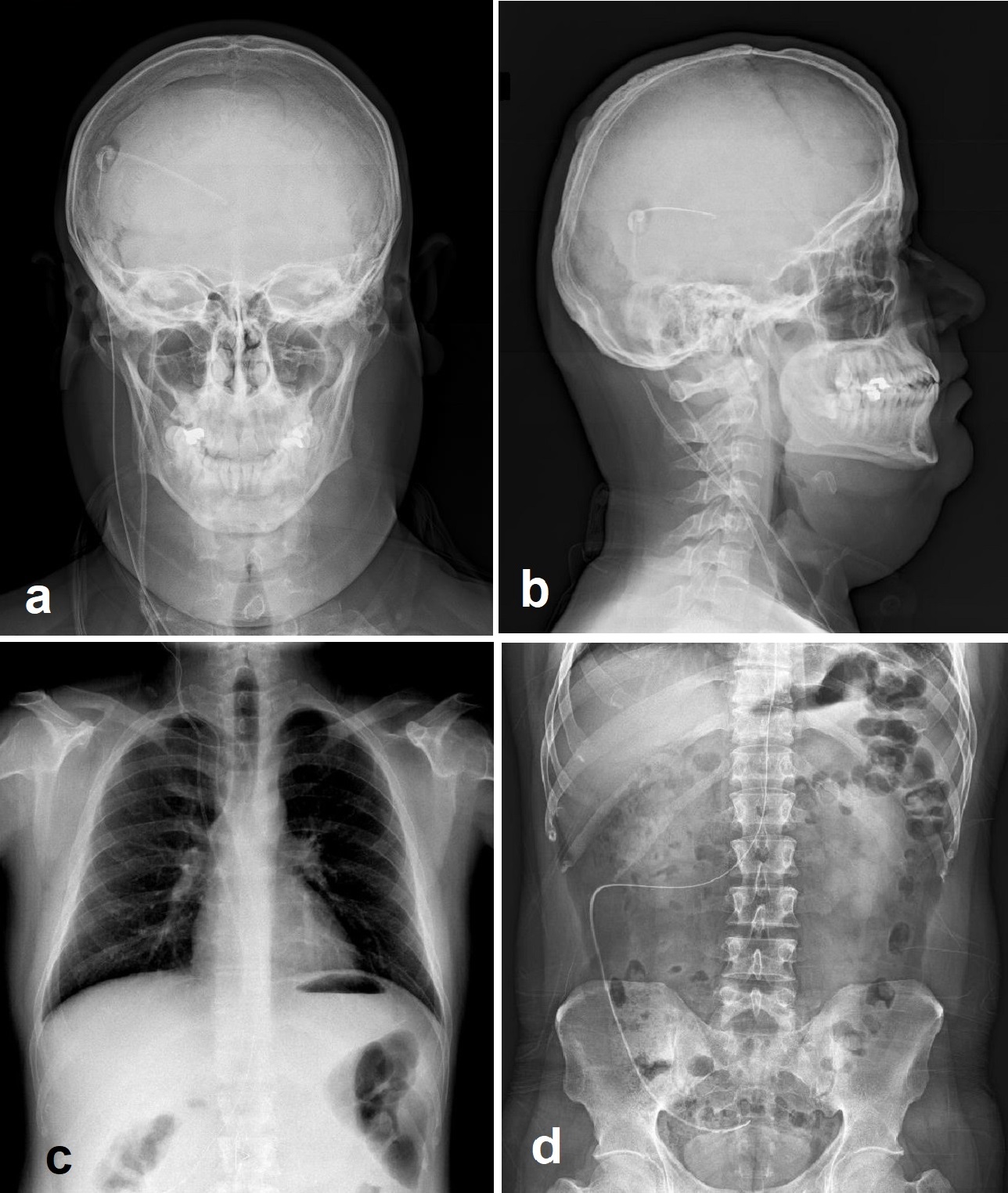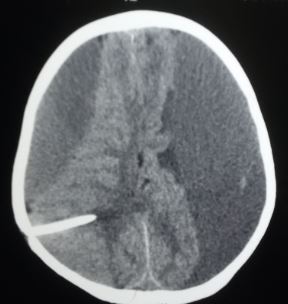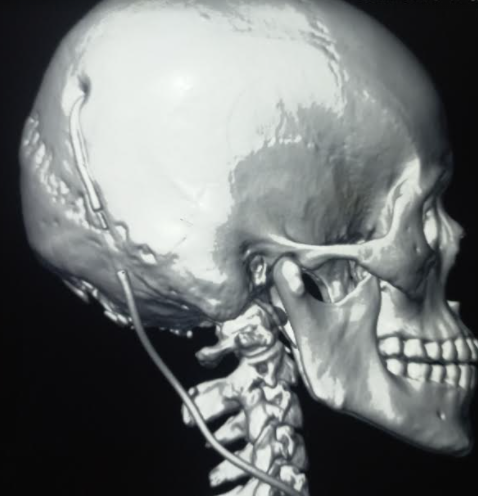[1]
Hanna RS, Essa AA, Makhlouf GA, Helmy AA. Comparative Study Between Laparoscopic and Open Techniques for Insertion of Ventriculperitoneal Shunt for Treatment of Congenital Hydrocephalus. Journal of laparoendoscopic & advanced surgical techniques. Part A. 2019 Jan:29(1):109-113. doi: 10.1089/lap.2017.0594. Epub 2018 Oct 10
[PubMed PMID: 30307809]
Level 2 (mid-level) evidence
[2]
Erps A, Roth J, Constantini S, Lerner-Geva L, Grisaru-Soen G. Risk factors and epidemiology of pediatric ventriculoperitoneal shunt infection. Pediatrics international : official journal of the Japan Pediatric Society. 2018 Dec:60(12):1056-1061. doi: 10.1111/ped.13709. Epub 2018 Dec 10
[PubMed PMID: 30290047]
[3]
Kutty RK, Sreemathyamma SB, Korde P, Prabhakar RB, Peethambaran A, Libu GK. Outcome of Ventriculosubgaleal Shunt in the Management of Infectious and Non-infectious Hydrocephalus in Pre-term Infants. Journal of pediatric neurosciences. 2018 Jul-Sep:13(3):322-328. doi: 10.4103/JPN.JPN_41_18. Epub
[PubMed PMID: 30271465]
[4]
Pan P. Outcome Analysis of Ventriculoperitoneal Shunt Surgery in Pediatric Hydrocephalus. Journal of pediatric neurosciences. 2018 Apr-Jun:13(2):176-181. doi: 10.4103/jpn.JPN_29_18. Epub
[PubMed PMID: 30090131]
[5]
Burhan B, Serdar KB, Abdurrahman A, Edip AM, Ebuzer D. Abdominal Complications of Ventriculoperitoneal Shunt in Pediatric Patients: Experiences of a Pediatric Surgery Clinic. World neurosurgery. 2018 Oct:118():e129-e136. doi: 10.1016/j.wneu.2018.06.140. Epub 2018 Jun 26
[PubMed PMID: 29959071]
[6]
Korzh V. Development of brain ventricular system. Cellular and molecular life sciences : CMLS. 2018 Feb:75(3):375-383. doi: 10.1007/s00018-017-2605-y. Epub 2017 Aug 5
[PubMed PMID: 28780589]
[7]
Hong B, Polemikos M, Heissler HE, Hartmann C, Nakamura M, Krauss JK. Challenges in cerebrospinal fluid shunting in patients with glioblastoma. Fluids and barriers of the CNS. 2018 Jun 4:15(1):16. doi: 10.1186/s12987-018-0101-x. Epub 2018 Jun 4
[PubMed PMID: 29860942]
[8]
Spirig JM, Frank MN, Regli L, Stieglitz LH. Shunt age-related complications in adult patients with suspected shunt dysfunction. A recommended diagnostic workup. Acta neurochirurgica. 2017 Aug:159(8):1421-1428. doi: 10.1007/s00701-017-3237-6. Epub 2017 Jun 14
[PubMed PMID: 28616668]
[9]
Rinaldo L, Lanzino G, Elder BD. Predictors of distal malfunction after ventriculoperitoneal shunting for idiopathic normal pressure hydrocephalus and effect of general surgery involvement. Clinical neurology and neurosurgery. 2018 Nov:174():75-79. doi: 10.1016/j.clineuro.2018.09.009. Epub 2018 Sep 5
[PubMed PMID: 30218879]
[10]
Jimenez DF, Keating R, Goodrich JT. Silicone allergy in ventriculoperitoneal shunts. Child's nervous system : ChNS : official journal of the International Society for Pediatric Neurosurgery. 1994 Jan:10(1):59-63
[PubMed PMID: 8194064]
[11]
Hussain NS, Wang PP, James C, Carson BS, Avellino AM. Distal ventriculoperitoneal shunt failure caused by silicone allergy. Case report. Journal of neurosurgery. 2005 Mar:102(3):536-9
[PubMed PMID: 15796391]
Level 3 (low-level) evidence
[12]
Kurin M, Lee K, Gardner P, Fajt M, Umapathy C, Fasanella K. Clinical peritonitis from allergy to silicone ventriculoperitoneal shunt. Clinical journal of gastroenterology. 2017 Jun:10(3):229-231. doi: 10.1007/s12328-017-0729-0. Epub 2017 Mar 6
[PubMed PMID: 28265895]
[13]
Morone PJ, Dewan MC, Zuckerman SL, Tubbs RS, Singer RJ. Craniometrics and Ventricular Access: A Review of Kocher's, Kaufman's, Paine's, Menovksy's, Tubbs', Keen's, Frazier's, Dandy's, and Sanchez's Points. Operative neurosurgery (Hagerstown, Md.). 2020 May 1:18(5):461-469. doi: 10.1093/ons/opz194. Epub
[PubMed PMID: 31420653]
[14]
Ros B, Iglesias S, Martín Á, Carrasco A, Ibáñez G, Arráez MA. Shunt overdrainage syndrome: review of the literature. Neurosurgical review. 2018 Oct:41(4):969-981. doi: 10.1007/s10143-017-0849-5. Epub 2017 Mar 29
[PubMed PMID: 28352945]
[15]
Bruce DA, Weprin B. The slit ventricle syndrome. Neurosurgery clinics of North America. 2001 Oct:12(4):709-17, viii
[PubMed PMID: 11524292]
[16]
Kashyap S, Ghanchi H, Minasian T, Dong F, Miulli D. Abdominal pseudocyst as a complication of ventriculoperitoneal shunt placement: Review of the literature and a proposed algorithm for treatment using 4 illustrative cases. Surgical neurology international. 2017:8():78. doi: 10.4103/2152-7806.206007. Epub 2017 May 10
[PubMed PMID: 28584681]
Level 3 (low-level) evidence
[17]
Harland TA, Winston KR, Jovanovich AJ, Johnson RJ. Shunt Nephritis: An Increasingly Unfamiliar Diagnosis. World neurosurgery. 2018 Mar:111():346-348. doi: 10.1016/j.wneu.2018.01.017. Epub 2018 Jan 8
[PubMed PMID: 29325951]
[18]
Satoskar AA, Parikh SV, Nadasdy T. Epidemiology, pathogenesis, treatment and outcomes of infection-associated glomerulonephritis. Nature reviews. Nephrology. 2020 Jan:16(1):32-50. doi: 10.1038/s41581-019-0178-8. Epub 2019 Aug 9
[PubMed PMID: 31399725]
[19]
Turkis OF, Karadag A, Middlebrooks EH, Senoglu M. Anal Extrusion of a Ventriculoperitoneal Shunt. Journal of the College of Physicians and Surgeons--Pakistan : JCPSP. 2019 May:29(5):478-480. doi: 10.29271/jcpsp.2019.05.478. Epub
[PubMed PMID: 31036124]
[20]
Bansal H, Gupta G, Gupta M, Kaushal R. Unusual Ventriculoperitoneal (VP) Shunt Tube Extrusion through Anus in a Child with Dandy Walker Malformation: A Rare Case Report. Journal of clinical and diagnostic research : JCDR. 2015 Jan:9(1):PD25-6. doi: 10.7860/JCDR/2015/11354.5488. Epub 2015 Jan 1
[PubMed PMID: 25738035]
Level 3 (low-level) evidence
[21]
Brownlee JD, Brodkey JS, Schaefer IK. Colonic perforation by ventriculoperitoneal shunt tubing: a case of suspected silicone allergy. Surgical neurology. 1998 Jan:49(1):21-4
[PubMed PMID: 9428890]
Level 3 (low-level) evidence
[22]
Junaid M, Ahmed M, Rashid MU. An experience with ventriculoperitoneal shunting at keen's point for hydrocephalus. Pakistan journal of medical sciences. 2018 May-Jun:34(3):691-695. doi: 10.12669/pjms.343.14081. Epub
[PubMed PMID: 30034441]
[23]
Nakajima M, Miyajima M, Ogino I, Akiba C, Kawamura K, Kurosawa M, Kuriyama N, Watanabe Y, Fukushima W, Mori E, Kato T, Sugano H, Karagiozov K, Arai H. Shunt Intervention for Possible Idiopathic Normal Pressure Hydrocephalus Improves Patient Outcomes: A Nationwide Hospital-Based Survey in Japan. Frontiers in neurology. 2018:9():421. doi: 10.3389/fneur.2018.00421. Epub 2018 Jun 7
[PubMed PMID: 29942280]
Level 3 (low-level) evidence
[24]
Tavares PAJ, Hamamoto Filho PT, Ferreira ASSBS, Avila MAG. Construction and Validation of Educational Material for Children with Hydrocephalus and Their Informal Caregivers. World neurosurgery. 2018 Jun:114():381-390. doi: 10.1016/j.wneu.2018.03.082. Epub 2018 Mar 19
[PubMed PMID: 29567289]
Level 1 (high-level) evidence
[25]
Joseph RA, Killian MR, Brady EE. Nursing Care of Infants With a Ventriculoperitoneal Shunt. Advances in neonatal care : official journal of the National Association of Neonatal Nurses. 2017 Dec:17(6):430-439. doi: 10.1097/ANC.0000000000000439. Epub
[PubMed PMID: 29166295]
Level 3 (low-level) evidence



